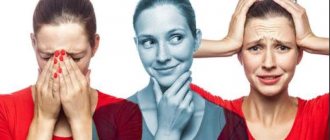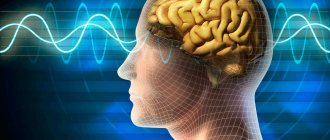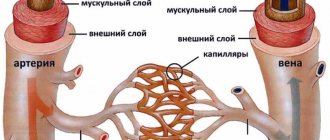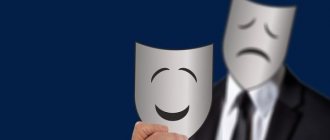Agitation is a condition in which the patient exhibits febrile motor agitation and demonstrates increased talkativeness.
The patient experiences anxiety, he fusses, does not find a place for himself, performs any actions automatically, and loses the ability to build logical chains. As a rule, agitation occurs against the background of a mental disorder. If the condition is not controlled, it can lead to the patient’s aggression, directed both at himself and at others.
Causes
Agitation can develop for a variety of reasons, including after severe stress. However, the most common cause is mental illness: schizophrenia, depression, neurosis, anxiety disorder. Agitation is also a frequent accompaniment of Alzheimer's disease and senile dementia.
Another group of reasons is drug intoxication, including that occurring during the treatment of mental disorders.
Agitation can occur with alcohol and drug poisoning.
Agitation in children most often manifests itself during recovery from general anesthesia.
Symptoms
The main symptoms of agitation are increased motor and speech activity of a non-constructive nature. A person repeatedly makes the same type of movements, shouts out the same phrases, without subjecting his actions to critical analysis.
Also, most patients experience:
- hand trembling;
- sweating;
- pale skin;
- cardiopalmus;
- labored breathing;
- increased blood pressure;
- hyperthermia;
- sleep disorders.
Agitation in depression is characterized by a rolling feeling of devastation after an attack. Episodes of hallucinations are occasionally observed.
Agitation in children: characteristic features
In children, agitation occurs during postoperative awakening from anesthesia. It manifests itself as uncontrollable agitation, inappropriate actions, and anxiety.
The child is aggressive towards the doctor and parents, does not give in to persuasion, is irritable, cries for a long time and inconsolably. The condition can last up to half an hour from the moment of regaining consciousness. Then the baby calms down on his own or with the help of medications.
The syndrome is observed in children aged from one to seven. Usually found in patients with prenatal and postnatal disorders, birth injuries.
Types of Bipolar Affective Disorder
In medical practice, there are several types of bipolar disorder:
- Type I with the manifestation of manic symptoms or mixed symptoms;
- Type II, which is characterized by depressive symptoms;
- cyclotomy;
- nonspecific disorder.
Each type has individual specifics, which influence the choice of therapy and prognosis for the development of the disease.
Bipolar manic disorder
At this stage, patients feel increased activity and are agitated. The patient exhibits activity and sociability, which are normally unusual for him. Sexual desire increases, the need for sleep sharply decreases. Patients feel their own greatness, experience ideas of their superiority.
Dysphoric mania may occur. Patients, instead of a feeling of superiority and increased activity, combined with a very good mood, experience constant irritability and dissatisfaction.
Bipolar depressive disorder
Characterized by decreased mood and activity. Patients lose interest in those things that previously seemed attractive and interesting. It is accompanied by disturbances in appetite and sleep, and with the development of pathology, suicidal thoughts arise.
Bipolar affective disorder
It differs in its course, in which frequent mood swings occur with a transition from mania or hypomania to a state of deep depression. With this type, mixed states are often observed, which are often indistinguishable from agitated depression, characteristic of people with neurological disorders and an exalted character. This may prevent timely contact with a specialist.
Diagnostics
The diagnosis is made by a psychiatrist; to clarify it, a consultation with a neurologist and narcologist may be required.
In addition to observing the patient’s behavior, the doctor measures pulse and blood pressure and collects family history. In some cases, the results of clinical and biochemical blood tests, measurement of hormone levels in the blood, urine analysis, and MRI of the brain may be required.
Blood tests are necessary to differentiate between agitation and akatasia, which are very similar in symptoms. Akatasia can occur as a result of taking medications (antidepressants and antipsychotics) that relieve agitation. An additional dose of these drugs can worsen the condition of a patient with akatasia.
Treatment
Depending on the severity of the symptoms, either a conversation is held with the patient, or an attack of agitation is stopped with medication, often in a hospital setting.
Treatment for the condition depends on the cause that caused it. Individual or group psychotherapy is indicated for patients who have suffered severe stress.
Patients need to create favorable conditions and adjust their sleep and wakefulness patterns. Relatives and friends of patients need to build trusting and supportive relationships with the patient.
How to live with bipolar disorder
People who have been diagnosed with bipolar disorder need to self-manage their health. Contacting a doctor is required at the first manifestation of symptoms. In this list:
- unexpected mood swings from unbridled joy to deep sadness over the course of several hours;
- loss of interest in life, leading to physical weakness and apathy;
- excessive excitement, in many cases accompanied by loud laughter and unmotivated joy;
- loss of appetite, weight can either begin to increase or decrease, the usual order of eating and taste preferences change.
Patients themselves may pay attention to other unusual factors caused by changes in their psycho-emotional state.
In the case of the presence of attacks in the past, patients with bipolar disorder know what symptoms may accompany the completion of remission. If there is a suspicion of a new attack, the patient is recommended to contact the treating psychologist or therapist.
At the same time, the diagnosis should not be perceived as a sentence that forces you to give up your usual way of life. With properly selected therapy and timely consultation with a doctor, bipolar disorder can go into a state of long-term, even lifelong, remission. Monitoring the patient’s condition by doctors and relatives, including the patient himself, is required for life. The lack of accurate data on the causes of this disease excludes the possibility of developing preventive measures.
Compliance with the rules for monitoring well-being and psycho-emotional state will help patients with bipolar disorder of any type maintain the quality of life of an almost completely healthy person. Attending psychotherapy courses and starting to take medications maintains emotional balance within normal limits in a large number of patients for many years. As a rule, others have no idea that a patient who constantly monitors himself has a complex and life-threatening pathology.
Drugs for the treatment of agitation
First and second generation antipsychotics and benzodiazepines are most often used in treatment.
Depending on the severity of the underlying disease, the drugs are taken orally or administered intramuscularly/intravenously.
To relieve an acute attack of agitation, the drug of choice is haloperidol, which is administered both in tablet form and intramuscularly. Olanzepine (Egolanza, Zolafren, Olfrex), sulpiride (Eglonil), and aripiprazole (Arilental, Frame, Zikalor) are also used.
Medicines to relieve agitation are used strictly as prescribed and under the supervision of a doctor!
Improvisations in literature of the 18th – 19th centuries
Improvisation played a significant role in the literary and salon life of the late 18th and early 19th centuries. Album lyrics have become widespread, the main improvisational genres of which are the epigram and the madrigal. The work of improvisational poets, who create impromptu songs commissioned by viewers, is becoming popular. A. Mickiewicz became famous for his spontaneous texts, who improvised in Polish poetry and French prose.
The very topic of improvisation in 19th-century literature is interesting. A. S. Pushkin in “Egyptian Nights” (1835) creates the image of an Italian improviser, depicting the art of improvisation as original and original, which requires poetic inspiration, skill and natural talent of the author. The specificity of improvisation and the poet’s book image are interpreted in the work of A. de Stael “Corinna, or Italy” (1807) and V. F. Odoevsky “The Improviser” (1833), where the technique of improvisation is considered as the dependence of the performer on the will of the listeners.
List of used literature
- Gelder M., Goeth D., Mayo R. Oxford Manual of Psychiatry / Trans. from English: In 2 volumes - K.: Sfera, 1999. - T. 2
- Nitrutsa M.I., Nagnibeda A.N. Emergency psychiatric care at the prehospital stage. – St. Petersburg: Special literature, 1998–2000.
- Protsenko D.N. International recommendations for the treatment of agitation and delirium in adult patients in intensive care units // Medical alphabet. – 2014. – T. 2. – No. 9.
- Smulevich A.B. Psychopathology and clinical picture of depression developing in schizophrenia // Psychiatry and psychopharmacotherapy. – 2003. – No. 5.
Bipolar disorder phase
In medical practice, there are two phases of this pathology:
- Depressive, characterized by a depressed mood, a feeling of hopelessness, decreased interest in everyday activities; patients develop self-rejection and a desire to commit suicide.
- Manic is accompanied by an increase in motor arousal, increased mood, and idiomatic mental arousal.
A significant proportion of patients are faced with a mixed version of the phases. When conducting an oral conversation with a doctor, manifestations of phases are revealed that are present simultaneously or appear with a short time interval.
Frequently asked questions about agitation
How to treat agitation?
The condition is treated with medications. Most often, the patient is hospitalized in a hospital. Subsequently, depending on what caused the agitation, the underlying disease is treated and a course of psychotherapy is prescribed, designed to stabilize the patient’s psychological state.
What can cause agitation?
The phenomenon develops against the background of mental illnesses - schizophrenia, depression, manic-depressive psychosis and anxiety disorders. The condition can also be caused by alcohol and drug intoxication, and drug poisoning. Agitation often accompanies senile dementia and Alzheimer's disease, and is observed in healthy people who have suffered severe stress.
Can agitation be cured?
This condition is not a disease. It can be described as a behavioral disorder that accompanies certain diseases. Their cure has a beneficial effect on the general condition of the patient. If agitation is caused by stress, psychotherapy, adherence to a daily routine, and a generally comfortable environment for the patient can cause an improvement in the condition without the use of medications.
Anxiety disorders in neurological practice
Clinically significant anxiety occurs in 5–7% of the general population and in 25% or more of patients seen by general practitioners. The lifetime incidence of anxiety disorders can be over 30%. Anxiety in adolescence and young adulthood often develops into depression later in life. The line between a “normal” response to threat and a pathological anxiety disorder is often quite blurred, and there may be a continuum from personality distress to mental disorder. This is precisely what causes the difficulties in diagnosing pathological anxiety, which is diagnosed half as often as depression.
Psychological or biological stress causes a normal (physiological) response of the body in the form of a psychophysiological reaction, manifested by anxiety symptoms and autonomic dysfunction. Symptoms are usually transient and well within the individual's control. Probably, such anxiety performs a signaling function (“alarm” mechanism) to prepare the body to “meet” danger (“fight” or “flight”). Alarm symptoms become clinically significant when:
- the severity of symptoms reaches a severe degree;
- the duration of symptoms is prolonged;
- symptoms develop in the absence of stress factors;
- symptoms impair the individual's physical, social or occupational functioning.
Conventionally, psychological symptoms of anxiety and various physical (somatic) symptoms are distinguished, most of which are associated with activation of the autonomic nervous system (Table).
Reliable diagnostic criteria for anxiety disorders set out in ICD-10 can provide some assistance in diagnosing pathological anxiety. According to modern classifications of mental disorders, anxiety disorders are divided into eight discrete categories: panic disorder (PD), generalized anxiety disorder (GAD), agoraphobia with panic disorder, obsessive-compulsive disorder, social phobia, specific phobias, post-traumatic stress disorder, acute stress disorder. Among chronic forms of anxiety, panic disorder and generalized anxiety disorder are the most commonly diagnosed by general practitioners. Any of the listed anxiety disorders can occur in a subclinical form.
In his daily practice, a neurologist encounters anxiety disorders that have various cause-and-effect relationships with the underlying (neurological) disease. At least three categories can be distinguished:
- primary pathological anxiety, manifested by “neurological” signs and symptoms (anxiety is manifested by symptoms that mimic a neurological disease);
- anxiety disorder comorbid with a current neurological disease, or mixed anxiety-depressive disorder comorbid with a current neurological disease;
- drug-induced anxiety resulting from treatment of the underlying disease.
Primary pathological anxiety
Patients suffering from primary pathological anxiety are observed by neurologists for a long time, i.e., the course of the disease is chronic. Most often they are given the following diagnoses: autonomic dystonia, neurocirculatory dystonia, autonomic crises, sympathoadrenal crises. The category of patients turning to a neurologist typically complains of “somatic” symptoms of anxiety, which are mostly a consequence of activation of the sympathetic division of the autonomic nervous system. Mental symptoms may not be recognized by the patient or may be regarded as a normal reaction to an “incomprehensible” painful condition. Only active questioning of patients makes it possible to identify mental anxiety symptoms along with autonomic dysfunction. Most often, patients suffering from GAD and panic attacks (PA) come to the attention of a neurologist.
GAD usually occurs before the age of 40 (the most typical onset is between adolescence and the third decade of life), and runs chronically for years with pronounced fluctuations in symptoms. Women develop GAD two or more times more often than men. The main manifestation of the disease is excessive anxiety or worry about everyday events that the patient cannot control. In addition, nonspecific symptoms of anxiety can be presented unlimitedly: vegetative (dizziness, tachycardia, epigastric discomfort, dry mouth, sweating, etc.); gloomy forebodings (worries about the future, premonitions of the “end”, difficulty concentrating); motor tension (motor restlessness, fussiness, inability to relax, tension headaches, chills). It is nonspecific somatic (vegetative) symptoms that often become the leading complaints of patients with GAD, which explains the previously accepted terms “vegetative dystonia” and “neurocirculatory dystonia”. Previously, GAD was considered by most experts to be a mild disorder that reaches clinical significance only in the case of comorbidity with depression. But increasing evidence of impaired social and professional adaptation of patients with GAD makes us take this disease more seriously.
PR is an extremely common disease prone to chronicity that manifests itself at a young, socially active age. The prevalence of birth defects according to epidemiological studies is 1.9–3.6% [1]. PR is 2–3 times more common in women. The main manifestation of PR is repeated paroxysms of anxiety (panic attacks). PA is an inexplicable, painful attack of fear or anxiety for the patient in combination with various vegetative (somatic) symptoms. In the domestic literature, the term “vegetative crisis” has long been used, reflecting ideas about the primacy of dysfunction of the autonomic nervous system.
Diagnosis of a panic attack is based on certain clinical criteria. A panic attack is characterized by paroxysmal fear (often accompanied by a feeling of impending doom) or anxiety and/or a feeling of internal tension in combination with four or more of the list of panic-associated symptoms.
List of panic-associated symptoms:
- Pulsation, palpitations, rapid pulse.
- Sweating.
- Chills, tremors, feeling of internal trembling.
- Feeling of lack of air, shortness of breath.
- Difficulty breathing, suffocation.
- Pain or discomfort in the left side of the chest.
- Nausea or abdominal discomfort.
- Feeling dizzy, unsteady, lightheaded, or lightheaded.
- Feeling of derealization, depersonalization.
- Fear of going crazy or committing an uncontrollable act.
- Fear of death.
- Feeling of numbness or tingling (paresthesia) in the extremities.
- Feeling of waves of heat or cold passing through the body.
The intensity of the main criterion of PA - paroxysmal anxiety - can vary widely from a pronounced affect of panic to a feeling of internal tension. In the latter case, when the vegetative component comes to the fore, they talk about “non-insurance” PA or “panic without panic”. Attacks depleted of emotional manifestations are more common in therapeutic and neurological practice. Panic-associated symptoms develop suddenly and reach their peak within 10 minutes. The post-attack period is characterized by general weakness and weakness.
PR has a special stereotype of the formation and development of symptoms. The first attacks leave an indelible mark on the patient’s memory, which leads to the appearance of an anxiety syndrome of “anticipation” of an attack, which in turn perpetuates the repetition of attacks. Repeating attacks in similar situations (in transport, while in a crowd, etc.) contributes to the formation of restrictive behavior, i.e. avoidance of places and situations that are potentially dangerous for the development of PA. The patient’s interpretation of PA as a manifestation of some physical disease leads to frequent visits to the doctor, consultations with specialists in various fields, unjustified diagnostic tests and creates in the patient the impression of the complexity and uniqueness of his disease. The patient's misconceptions about the essence of the disease lead to the appearance of hypochondriacal symptoms, which contribute to the worsening of the disease.
Anxiety disorder comorbid with a current neurological disease
Anxiety disorder in patients with comorbid neurological or somatic disease can manifest itself with various symptoms that are described in primary pathological anxiety. Anxiety is particularly associated with the following chronic neurological diseases: epilepsy, stroke, multiple sclerosis, chronic pain syndromes, migraines, Parkinson's disease and other degenerative diseases. The need to differentiate the many physical symptoms of anxiety from those of a physical or neurological disease becomes a significant challenge in some cases. Alarming symptoms can be mistakenly regarded as signs of a neurological disease, which often leads to unnecessary therapy.
The clinical manifestation of anxiety symptoms often does not meet the criteria for a delineated anxiety disorder and represents a recurrent group of symptoms with less duration and severity than required for syndromic classification. These subsyndromal anxiety disorders are the most difficult to diagnose and often remain untreated, while having an extremely negative impact on the quality of life of the patient and those around him. Subsyndromal anxiety disorder is often a risk factor for developing severe depression. Comorbid anxiety disorder, regardless of its severity, has a significant negative impact on the course of the underlying (neurological) disease. For example, anxiety can lead to an increase in epileptic seizures or disruption of drug remission, and prolong the rehabilitation period in patients who have suffered a stroke. Mild anxiety disorders correspond to syndromic ones in duration, but include a smaller number (from 2 to 4) of anxiety symptoms or more than four symptoms, the insignificant severity (severity) of which does not fully satisfy the diagnostic criteria. A study of the quality of life in patients suffering from subsyndromal or mild anxiety showed that in terms of parameters of professional and social activity, the decrease in quality of life in them is comparable to patients with a full-blown anxiety disorder, and significantly worse than in people with a chronic disease uncomplicated by psychopathological syndromes [2].
Drug-induced anxiety
Many medications and other chemical substances can cause alarming symptoms. Excessive caffeine consumption or abrupt cessation of caffeine consumption causes significant anxiety symptoms [3]. Various receptor medications contribute to the manifestation of anxiety, which is interpreted as a side effect of the drug. The following may cause anxiety: adrenergic agonists, bronchodilators, corticosteroids, drugs that affect thyroid function, antihypertensive drugs, cardiovascular drugs, especially digitalis derivatives. Psychotropic drugs such as antipsychotics and, less commonly, selective serotonin reuptake inhibitors (SSRIs) may cause akathisia, which is associated with anxiety. All antidepressants demonstrate an anti-anxiety effect with long-term use. However, in the initial period of treatment, all antidepressants, without exception, can induce anxiety, which in many cases is the reason for the patient’s refusal of therapy. The combination of an antidepressant with an anti-anxiety drug during the initial period of treatment makes the therapy generally more successful.
It is well known that alcohol withdrawal causes anxiety and agitation. Many pathological anxiety symptoms debut during the abstinence period. Symptoms of withdrawal from sedative-hypnotics are similar in pathogenesis and clinical manifestations to symptoms of alcohol withdrawal, but are often underestimated by clinicians as a potential cause of anxiety. Both of these conditions are characterized by the following alarming symptoms: nervousness, tachycardia, trembling, sweating and nausea. At the same time, sedatives (benzodiazepines) are used to treat anxiety symptoms. Therefore, there are difficulties in differentiating symptoms of an underlying anxiety disorder from withdrawal symptoms associated with the use of these medications.
Principles of therapy for anxiety disorders
Anxiety disorders are diagnosed in only 50% of patients with obvious symptoms [4]. Fewer than 50% of patients receive any treatment and less than 30% receive adequate therapy. Mild and subthreshold anxiety disorders are often not considered targets for treatment at all. As a result, anxiety becomes chronic, transforms into more severe psychopathological syndromes and extremely worsens the quality of life. In addition, in the case of comorbidity with somatic pathology, anxiety significantly complicates and aggravates the course of the underlying disease. Despite the obligatory nature of autonomic dysfunction and the often masked nature of emotional disorders, the basic method of treating anxiety is psychopharmacological treatment. The therapeutic strategy must be built depending on the type of dominant disorder and the degree of its severity. The choice of drug depends on the severity of the anxiety level and the duration of the disease.
The range of anti-anxiety drugs is extremely wide: tranquilizers (benzodiazepine and non-benzodiazepine), sedative herbal preparations and, finally, antidepressants, minor antipsychotics. But pharmacological treatment for anxiety disorders is far from optimal.
Tranquilizers are primarily used to relieve acute symptoms of anxiety. The fairly rapid achievement of an anti-anxiety, primarily sedative effect, and the absence of obvious adverse effects on the functional systems of the body justify the well-known expectations of doctors and patients, at least at the beginning of treatment. Classic benzodiazepine tranquilizers are indicated for the management of acute reactions to extreme stressors. At the same time, non-benzodiazepine anxiolytics are most often used to correct reactions to ordinary stressful events, accompanied by a decrease in adaptive capabilities.
Despite the large number of anxiolytic agents, there remains a need to introduce more effective anxiolytics with a more favorable tolerability and safety profile. A fundamentally new approach in the pharmacotherapy of anxiety disorders is the use of release-active drugs. One of the representatives of this group is the drug Tenoten. Tenoten contains antibodies in a release-active form to the neurospecific protein S-100 (PA-AT S-100).
It is known that there is a clear relationship between the development of anxiety disorders and representatives of the multifamily of S-100 proteins, among which the key role is played by the brain-specific protein S-100B. Protein S-100 is involved in the implementation of the fundamental functions of the neural systems of the brain, such as the generation and conduction of nerve impulses, strengthening of synaptic transmission, better interaction of leading neurotransmitters with receptors (GABA, serotonin, sigma1-, NMDA), coupling of synaptic and metabolic processes, proliferation and differentiation of neurons and glial cells. Drugs that regulate the activity of the S-100 protein have clear clinical anti-anxiety effects and additionally help restore the processes of neuronal plasticity. The absence of depressant and muscle relaxant effects, “behavioral toxicity”, paradoxical reactions, dependence and “withdrawal” syndrome, compatibility with drugs of other groups determine the prospects for the use of Tenoten in socially active groups of the population.
Numerous studies have shown the effectiveness and safety of Tenoten in patients with severe somatoneurological disorders. Thus, the administration of the drug Tenoten for 4 weeks to young patients with autonomic dystonia and emotional disorders led to a significant decrease in the severity of symptoms of autonomic dysfunction, anxiety and depressive disorders and, accordingly, an increase in the quality of life of patients [5].
When observing a group of 60 patients with transient ischemic attacks in various vascular systems and concomitant emotional disorders, it was found that the use of Tenoten was also accompanied by a decrease in the severity of anxiety [6]. According to the authors of the study, the effectiveness of Tenoten did not differ significantly from that of phenazepam, although the tolerability of Tenoten was significantly better.
It was also demonstrated that the combined use of Tenoten with anti-inflammatory therapy for 8 weeks in patients with chronic pain syndrome due to spinal osteochondrosis and psychovegetative disorders led not only to a decrease in anxiety, but also a significant decrease in the intensity of the pain syndrome. This allowed the authors to consider Tenoten as a drug that reduces the negative impact of pain on quality of life [7].
Combination therapy with Tenoten with antihypertensive drugs allowed patients with arterial hypertension and anxiety disorders to more quickly achieve target blood pressure values [8].
A subsequent analysis of the results of a number of studies on the use of Tenoten for the correction of affective disorders in patients with neurological and somatic pathologies confirmed the effectiveness of the drug and its good tolerability [9].
There are no clear recommendations for the duration of treatment for anxiety syndromes. However, most studies have proven the benefits of long courses of therapy. It is believed that after the reduction of all symptoms, at least four weeks of drug remission must pass, after which an attempt is made to discontinue the drug. Stopping the medication too early can lead to an exacerbation of the disease. Residual symptoms (most often symptoms of autonomic dysfunction) indicate incomplete remission and should be considered as a marker for prolongation of therapy and transition to an alternative treatment regimen. On average, course therapy is at least two months.
Literature
- Perkonigg A., Wittshen HU Epidemiologie von Angststorungen. In: Kaster S, Muller HJ, eds. Angst- und Panikerkrankung. Jena: Gustav Fischer Verlag, 1995; 137–156.
- Katon W., Hollifield M., Chapman T. et al. Infrequent panic attacks: psychiatric comorbidity, personal characteristics and functional disability // J Psych Research. 1995; 29: 121–131.
- Bruce M., Scott N., Shine P., Lader M. Anxiogenic effects of caffeine in patients with anxiety disorders // Arch Gen Psychiatry. 1992; 49:867–869.
- Sartorius N., Ustun TB, Lecrubier Y., Wittchen HU Depression comorbid with anxiety: results from the WHO study on psychological disorders in primary health care // Br J Psychiatry. 1996; 168: 38–43.
- Dyakonova E. N. et al. Effective therapy of vegetative-vascular dystonia in young patients // Attending physician. 2021. No. 2. pp. 1–7.
- Amosov M. L., Saleev R. A., Zarubina E. V., Makarova T. V. Use of the drug Tenoten in the treatment of emotional disorders in patients with transient cerebrovascular accidents // Russian Psychiatric Journal. 2008; 3:86–91.
- Loginov V. G., Tsurko K. I., Fedulov A. S. “The effect of the drug Tenoten on the level of anxiety and depression in patients with chronic pain syndrome with neurological manifestations of spinal osteochondrosis,” Neurology and Neurosurgery. Eastern Europe. 1 (25). 2015. pp. 132–138.
- Nikolskaya I.N., Guseva I.A., Bliznevskaya E.V., Tretyakova T.V. The role of anxiety disorders in hypertension and the possibility of their correction // Attending physician. 2007. No. 3. pp. 89–90.
- Shavlovskaya O. A. Use of the drug Tenoten in clinical practice. Effective pharmacotherapy // Neurology and Psychiatry. 2011; 4: 18–22.
O. V. Vorobyova, Doctor of Medical Sciences, Professor V. V. Rusaya, Candidate of Medical Sciences
FSBEI HE First Moscow State Medical University named after. I. M. Sechenova Ministry of Health of the Russian Federation, Moscow
Contact Information










